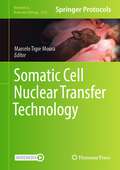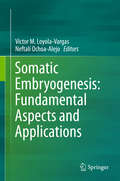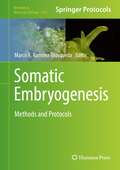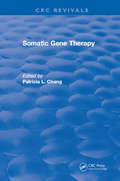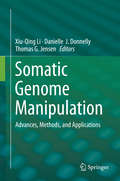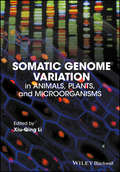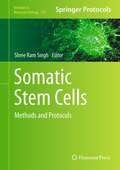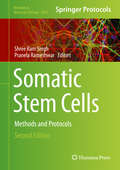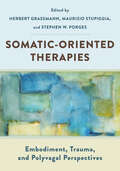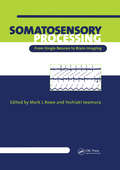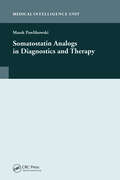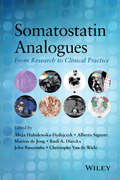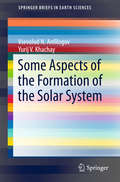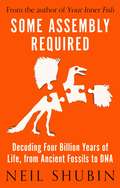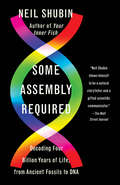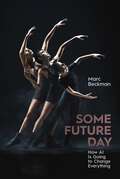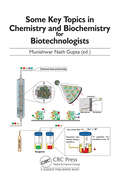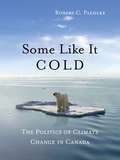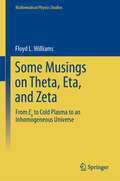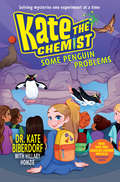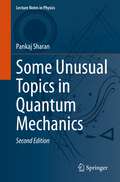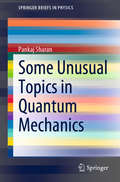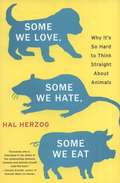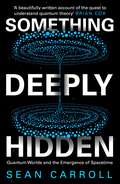- Table View
- List View
Somatic Cell Nuclear Transfer Technology (Methods in Molecular Biology #2647)
by Marcelo Tigre MouraThis volume details protocols on animal cloning by Somatic cell nuclear transfer for basic research and biotechnological applications. Written in the format of the highly successful Methods in Molecular Biology series, each chapter includes an introduction to the topic, lists necessary materials and methods, includes tips on troubleshooting and known pitfalls, and step-by-step, readily reproducible protocols. Authoritative and cutting-edge, Somatic Cell Nuclear Transfer Technology aims to be comprehensive guide for researchers.
Somatic Embryogenesis: Fundamental Aspects and Applications
by Neftalí Ochoa-Alejo Víctor M Loyola-VargasThis book discusses basic andapplied aspects of somatic embryogenesis, one of the most powerful tools inplant biotechnology. It is divided into three parts; Part I includes topicssuch as the history of this research field, how differentiated plant cells can(re)acquire totipotency, molecular features, as well as the epigenetics andproteomics of somatic embryogenesis. Part II coversthe somatic embryogenesis of different crops, such as Agave spp. maize, Cocos nucifera, Bixa orellana,Capsicum spp. , Coffea spp. , Musa spp. , Pinus spp. , and Arabidopsis thaliana. Various applications, like scale-up propagationand genetic engineering are discussed in detail in Part III. The book will appealto plant scientists, plant breeders and experts working in industry.
Somatic Embryogenesis: Methods and Protocols (Methods in Molecular Biology #2527)
by Marco A. Ramírez-MosquedaThis volume provides an overview of methods for plant species, mainly species with high economic value, to achieve in vitro propagation through somatic embryogenesis. Chapters guide readers through somatic embryogenesis protocols, somatic embryos in plants, and new methodologies that are used out to solve in vitro recalcitrance of many species to this morphogenetic route. Written in the format of the highly successful Methods in Molecular Biology series, each chapter includes an introduction to the topic, lists necessary materials and reagents, includes tips on troubleshooting and known pitfalls, and step-by-step, readily reproducible protocols. Authoritative and cutting-edge, Somatic Embryogenesis: Methods and Protocols aims to guide future researcher to achieve success in obtaining and regenerating somatic embryos. Chapter 6 is available open access under a Creative Commons Attribution 4.0 International License via link.springer.com.
Somatic Gene Therapy
by P.L. ChangAs human gene therapy becomes a clinical reality, a new era in medicine dawns. Novel and innovative developments in molecular genetics now provide opportunities to treat the genetic bases of diseases often untreatable before. Somatic Gene Therapy documents these historical clinical trials, reviews current advances in the field, evaluates the use of the many different cell types and organs amenable to gene transfer, and examines the prospects of various exciting strategies for gene therapy.
Somatic Genome Manipulation
by Xiu-Qing Li Danielle J. Donnelly Thomas G. JensenSomatic genome manipulation is required when a sexual crossing approach cannot be used in breeding or genetic treatment of an individual organism. Examples can include gene- or cell-therapy of a person to correct disease, genetic improvement of vegetatively propagated plants, and genetic replacement of cytoplasm without significantly modifying the nuclear genome. The advantage of somatic genome manipulation is maintenance of the general genotype while correcting one or more traits. Somatic genome manipulation is also an option for genetic improvement of sexually propagated plants in polyploidy breeding or in overcoming issues of sexual incompatibility. Recent novel technologies in somatic genome manipulation are developing quickly but much of this literature is fragmented and difficult or inconvenient to access. This book represents the first attempt to assemble updated reviews, detailed protocols, and their applications in all fields in which somatic genome manipulation has thrived. This is a truely one-of-a-kind work that brings together the most important and relevant advances in somatic genome manipulation in plants, algae, microorganisms, humans and animals, and demonstrates where the science interacts and where it diverges. The chapters are written by experts on the topic with ready-to-use protocols that were originally developed or adapted from the literature in their laboratories. We expect that this book will be useful for students, researchers, and teachers in both plant and animal research as a resource for the latest information on somatic genome manipulation and for its useful laboratory methods.
Somatic Genome Variation
by Xiu-Qing LiWritten by an international team of experts, Somatic Genome Variation presents a timely summary of the latest understanding of somatic genome development and variation in plants, animals, and microorganisms. Wide-ranging in coverage, the authors provide an updated view of somatic genomes and genetic theories while also offering interpretations of somatic genome variation. The text provides geneticists, bioinformaticians, biologist, plant scientists, crop scientists, and microbiologists with a valuable overview of this fascinating field of research.
Somatic Stem Cells
by Shree Ram SinghStem cells are found in almost all organisms from the early stages of development to the end of life. There are several types of stem cells and all of them may prove useful for medical research; however, each of the different types has both promise and limitations. Somatic Stem Cells: Methods and Protocols presents selected genetic, molecular, and cellular techniques used in somatic stem cell research and its clinical application. Chapters focus on the isolation, characterization, purity, plasticity, and clinical uses of somatic stem cells from a variety of human and animal tissues. Written in the highly successful Methods in Molecular BiologyTM series format, chapters include introductions to their respective topics, lists of the necessary materials and reagents, step-by-step, readily reproducible laboratory protocols, and key tips on troubleshooting and avoiding known pitfalls. Through and intuitive, Somatic Stem Cells: Methods and Protocols seeks to provides scientists with the fundamental techniques of stem cell research and its potential application in regenerative medicine.
Somatic Stem Cells: Methods And Protocols (Methods in Molecular Biology #879)
by Shree Ram Singh Pranela RameshwarThis second edition volume expands on the previous edition with updated discussions on new genetic, molecular, and cellular methods used to study somatic stem cells. The chapters in this book focus on the isolation, classification, purity, and plasticity of these stem cells in a variety of organic tissues. Written in the highly successful Methods in Molecular Biology series format, chapters include introductions to their respective topics, lists of the necessary materials and reagents, step-by-step, readily reproducible laboratory protocols, and tips on troubleshooting and avoiding known pitfalls.Cutting-edge and comprehensive, Somatic Stem Cells: Methods and Protocols, Second Edition is a valuable resource for both novice and experienced molecular biologists, developmental biologists, tissue engineers, and geneticists who are interested in stem cell research and its potentials in regenerative medicine.
Somatic-Oriented Therapies: Embodiment, Trauma, and Polyvagal Perspectives
by Stephen W. Porges Herbert Grassmann Maurizio StupiggiaAn innovative collection of research and theory from leading voices in the fields of trauma and somatic therapies. Somatic-Oriented Therapies represents a significant consolidation of innovative research and clinical approaches aimed at addressing trauma through various somatic modalities. In the past six decades, a multitude of therapeutic methods have emerged globally, revolutionizing trauma treatment and existential distress management. However, these approaches have often diverged, hindering the development of a cohesive, distinct field independent of traditional paradigms. This volume of collected work from some of the world’s leading experts in trauma aims to delineate this novel domain of research and clinical intervention. It elucidates the common thread linking the contributing authors and introduces a new clinical perspective. Central to this perspective is the recognition of the profound significance of the body-to-body relationship between therapist and patient; the critical role of trust establishment within the clinical context as a prerequisite for deep transformation; and the possibility to “question” the body, finding “unthought-of” avenues of transformation. Contributors include: Michael Allison, Martina Ardizzi, Ken Benau, David Berceli, Sue Carter, Cristiano Crescentini, Francesca Ferroni, Aaron Freedman, Vittorio Gallese, Jeltje Gordon-Lennox, Susan Harper, Molly Boeder Harris, Bach Ho, Steve Hoskinson, Hanneke Kalisvaart, J. David Knottnerus, Jacek Kolacz, Aline La Pierre, Rabih Lahoud, Francois Le Doze, Chairaa Marazzi, Alessio Matiz, Emily Newcomer, Pat Ogden, Antonia Pfeiffer, Betsy Polatin, Alessandra Pollazzon, Robert Schleip, Arielle Schwartz, Raja Selvam, Jane Shaw, Marlysa Sullivan, Jennifer Tantia, Chantal Traub, Donnalea Van Vleet Goelz, Ruby Jo Walker, Jan Winhall, Zabie Yamasaki, and Silvia Zanotta.
Somatosensory Processing: From Single Neuron to Brain Imaging
by Mark Rowe Yoshiaki IwamuraThe diversity of contemporary investigative approaches included in this volume provides an exciting account of our current understanding of brain mechanisms responsible for sensory and perceptual experience in the areas of touch, kinesthesia, and pain.Postgraduate research students in sensory physiology, neurology, psychology and anatomy, and r
Somatostatin Analogs in Diagnostics and Therapy
by Marek PawlikowskiSomatostatin is a peptide isolated originally from the hypothalamus and considered as an inhibitor of growth hormone secretion. However, further studies have shown that the peptide was ubiquitously distributed and exerts a large spectrum of physiological effects, mostly of an inhibitory nature. The very short half-life of the native peptide limits
Somatostatin Analogues
by Alberto Signore Christophe Van de Wiele Rudi A. Dierckx Alicja Hubalewska-Dydejczyk John Buscombe Marion De JongFeaturing chapters from specialists in endocrinology, physiology, pathology, and nuclear medicine, this book provides a multidisciplinary approach to a wide variety of issues concerning somatostatin and its analogues. The book: Provides the most up-to-date coverage of somatostatin analog use in diagnostic and therapy Integrating the specialties of endocrinology, physiology, pathology, and nuclear medicine, providing the multidisciplinary approach to the topic Focuses on future applications, novel compounds, and areas for further research Covers topics by authors who are renowned experts and researchers in the field
Some Aspects of the Formation of the Solar System
by Vsevolod N. Anfilogov Yurij V. KhachayThis book is devoted to the problems that occur when attempting to understand and construct a concise representation of the original conditions, composition and dynamics of the evolution of the Earth-Moon system in the form in which it is seen today. This volume will perhaps contribute to a better understanding of what is necessary to research the dynamics of the Solar system.
Some Assembly Required: Decoding Four Billion Years of Life, from Ancient Fossils to DNA
by Neil ShubinThe author of the bestselling Your Inner Fish gives us a brilliant, up-to-date account of the great transformations in the history of life on Earth. Over billions of years, fish evolved to walk on land, reptiles transformed into birds that fly, and ape-like primates changed into humans who walk on two legs, talk and write. This is a story full of surprises. If you think that feathers arose to help animals fly, or lungs to help them walk on land, you&’d be in good company. You&’d also be entirely wrong. Neil Shubin delves deep into the mystery of life, the ongoing revolutions in our understanding of how we got here, and brings us closer to answering one of the great questions – was life on earth inevitable…or was it all an accident?
Some Assembly Required: Decoding Four Billion Years of Life, from Ancient Fossils to DNA
by Neil ShubinThe author of the best-selling Your Inner Fish gives us a lively and accessible account of the great transformations in the history of life on Earth--a new view of the evolution of human and animal life that explains how the incredible diversity of life on our planet came to be.Over billions of years, ancient fish evolved to walk on land, reptiles transformed into birds that fly, and apelike primates evolved into humans that walk on two legs, talk, and write. For more than a century, paleontologists have traveled the globe to find fossils that show how such changes have happened. We have now arrived at a remarkable moment—prehistoric fossils coupled with new DNA technology have given us the tools to answer some of the basic questions of our existence: How do big changes in evolution happen? Is our presence on Earth the product of mere chance? This new science reveals a multibillion-year evolutionary history filled with twists and turns, trial and error, accident and invention. In Some Assembly Required, Neil Shubin takes readers on a journey of discovery spanning centuries, as explorers and scientists seek to understand the origins of life's immense diversity.
Some Future Day: How AI Is Going to Change Everything
by Marc BeckmanThis cutting-edge guide not only shows how AI is transforming our careers, lives, businesses, and more, but also provides easy, actionable steps to make AI work for us. In this groundbreaking book, celebrated professor, entrepreneur, author, and podcaster Marc Beckman explores the transformative power of artificial intelligence (AI) and how it&’s poised to enhance and transform all aspects of society—revolutionizing our careers, enriching our family lives, and bringing our communities closer together. From business and advertising, to medicine, to warfare, to politics—Beckman meticulously explores the different areas where we&’ll soon feel AI&’s transformative impact. But that&’s only half of it. Throughout this book, he also provides the specific steps readers can take now to make sure these coming changes work for them. From the workplace to the home, AI is poised to reshape the way we approach our professional and personal lives. Beckman uses this book to make the case that AI will free up valuable time and energy, allowing individuals to focus on more creative and meaningful work, but also that AI will create possibilities for engagement that were unthinkable just a generation ago. He shows that with AI as our co-pilot, we&’ll unlock new opportunities for growth, innovation, and collaboration—all of which will lead to more fulfilling and rewarding careers. Beckman illustrates how AI will strengthen family bonds and improve the quality of our home lives too, changing everything from how we educate our kids to how we stay connected on social media. And as AI becomes more integrated into our cities and towns, it will play a crucial role in fostering a sense of community and belonging; through AI-powered platforms, Beckman shows how we will collaborate on projects, share resources, and support one another in times of need. This thought-provoking and essential book is a definitive guide to the many ways in which AI will transform our lives for the better . . . but also surprise us, delight us, force us to (re)consider how we interact with one another, and make us question what exactly counts as &“human.&” Join Marc Beckman on this exciting journey as he explores the near-endless possibilities of a world powered and transformed by artificial intelligence. It&’s an Age of Imagination . . . where the only limit is your own mind.
Some Key Topics in Chemistry and Biochemistry for Biotechnologists
by Munishwar Nath GuptaThe book is aimed at providing an exposure to some important topics which are generally not covered adequately in formal courses in biotechnology. It informs the readers about: How micro-fluidics are proving useful in enzyme kinetics. Chemi-proteomics; combinatorial chemistry and high-throughput screening in the context of drug discovery. How enzymes can be used with gaseous substrates? How to source more robust enzymes from marine resources for diverse applications? Why some nano-materials can be chiral? Synthesis of diverse quantum dots as powerful fluorescent probes in biology. How basics of surface chemistry and immunology are vital in dealing with endemics/pandemics like Covid-19.
Some Like It Cold: The Politics of Climate Change in Canada
by Robert C. PaehlkeSome Like It Cold plunges headlong into the political conundrum of Canada’s climatechange debate. Focusing on the past responses of both Liberal and Conservative governmentsto the looming crisis—ranging from negligence to complicity and connivance—Paehlke illuminatesthe issues surrounding compliance with global regulations such as Kyoto, includingthe dilemma of tar sands development. But he also lays out crucial political steps that could, if taken, lead towards a solution. While he presents a potentially positive projection for the future, Paehlke is not afraid topoint a finger at Canada’s fractured and flawed democracy—demonstrating that the country’sambivalence is our biggest hindrance to joining the international quest to move forward onthis unparalleled global challenge.
Some Musings on Theta, Eta, and Zeta: From E8 to Cold Plasma to an lnhomogeneous Universe (Mathematical Physics Studies)
by Floyd L. WilliamsThis book continues the applications of mathematics, more specifically of theta, eta, and zeta functions, and modular forms, to various areas of theoretical physics. It is a follow-up and extension in some sense of the author’s earlier book entitled A window into zeta and modular physics. Some of the main topics are1. A new approach to logarithmic corrections to black hole entropy2. My recent work that provides for an explicit cold plasma-black hole connection3. Generalization of work of physicists on certain asymptotic problems relating to string theory, for example, by way of the general theory of modular forms of non-positive weight4. A construction of the E8 root lattice, its theta function, and its relevance for heterotic string theory5. Applications of elliptic functions to KdV, nonlinear Schrödinger, and Duffing equations, for example, including a discussion of Lax pairs and the Miura transformation6. Finite temperature zeta functions and partition functions for quantum fields in thermal equilibrium on various curved background spacetimes7. Exact solutions of the Einstein gravitational field equations for Lemaitre and inhomogeneous cosmological models, with a special focus on the Szekeres–Szafron exact solutions by way of the Weierstrass elliptic function8. Elementary particles and my zeta function formula for higher spin fermionic particles; this covers, in particular, the gravitino particle (of spin 3/2) and bosons with integral spin s = 2, 3, 4, 5.These are some sample topics. Others include the continuous Heisenberg model, reaction diffusion systems, Dirichlet and Hecke L-functions, the modular j-invariant, the computation of the one-loop effective potential for non-compact symmetric spaces, the BTZ black hole, Jacobi inversion formulas, etc.Thus, there is a very large range of material with the first 9 chapters of preliminary, expositional background for mathematicians and physicists.
Some Penguin Problems (Kate the Chemist)
by Dr. Kate BiberdorfThere are some penguin problems on the fifth-grade field trip in this fifth installment of the Kate the Chemist fiction series that shows kids that everyone can be a scientist! Perfect for fans of the Girls Who Code series.When Kate learns that her class is going on a field trip to the aquarium, she is thrilled that she'll get to see the penguin exhibit! The rockhopper penguins are her favorite. To prepare, Ms. Eberlin assigns the class a project: each student has to do a report about a different animal at the aquarium. Even though Kate gets assigned sea lions, she's still thrilled to go. Kate, Birdie, and the rest of the class excitedly prepare for their projects until it's finally Aquarium Day! But when a huge snowstorm threatens to ruin the class's field trip, will Kate the Chemist be able to save the day with science? From Kate the Chemist, chemistry professor and science entertainer as seen on The Late Show with Stephen Colbert, The Wendy Williams Show, and The Today Show, comes a clever and fun middle grade series that is the perfect introduction to STEM for young readers!Make Your Own Chocolate-Covered Pretzels! Experiment Inside! Praise for the Kate the Chemist series:"Proves that science and fun go together like molecules in a polymer."--School Library Journal"It's a great introduction to the basics of chemistry that is readily accessible to a variety of ages . . . The way the everyday chemistry is blended in is done seamlessly, and has [me and my ten-year-old son] noticing how we are all doing a little bit of science every day." --GeekMom.com
Some Unusual Topics in Quantum Mechanics (Lecture Notes in Physics #1020)
by Pankaj SharanThis second edition of Some Unusual Topics in Quantum Mechanics builds upon the topics covered in the first, with additional chapters that delve deeper into the mathematical foundations of the subject. New topics include Hilbert spaces and unbounded operators, minimum uncertainty states, path integrals in general coordinates, Fock spaces, second quantization, relativistic particle states, and quantum fields. Historical insights are also included, such as a pre-history of matrix mechanics and Pauli's proof of the H-atom spectrum using O(4) symmetry. Finally, readers are introduced to Bell's inequality and the non-locality in quantum mechanics that is revealed through its violation. These topics are rarely covered in introductory textbooks but are crucial to developing a student's interest and deeper understanding of quantum mechanics. This book serves as valuable supporting material for graduate-level core courses on the subject.
Some Unusual Topics in Quantum Mechanics (SpringerBriefs in Physics)
by Pankaj SharanIn this book, the author addresses selected topics in quantum mechanics that are not usually covered in books, but which are very helpful in developing a student's interest in, and a deeper understanding of the subject. The topics include two different ways of looking at quantum mechanics; three clarifying topics that students often find confusing; one classic theorem never proved in the classroom; and a discussion on whether there can be a non-linear quantum mechanics. The book can be used as supporting material for graduate-level core courses on quantum mechanics.
Some We Love, Some We Hate, Some We Eat: Why It's So Hard to Think Straight About Animals
by Hal HerzogIn this work, the author shows us how whimsical our attitudes toward animals, birds, and fish can be. Why do we like some animals but not others? Research has shown that the human brain is wired to think about animals and inanimate objects differently, and Herzog reveals how we can look at the exact same animal very differently given its context. This book invites us to think deeply about how we view animals, how we make inconsistent ethical choices regarding their welfare, and how we limit our empathy for their well-being.
Someone Builds the Dream
by Lisa WheelerBuildings, bridges, and books don't exist without the workers who are often invisible in the final product, as this joyous and profound picture book reveals from acclaimed author of The Christmas Boot Lisa Wheeler and New York Times bestselling illustrator of Love Loren Long <P><P> All across this great big world, jobs are getting done<br> by many hands in many lands. It takes much more than ONE. <P><P> Gorgeously written and illustrated, this is an eye-opening exploration of the many types of work that go into building our world--from the making of a bridge to a wind farm, an amusement park, and even the very picture book that you are reading. An architect may dream up the plans for a house, but someone has to actually work the saws and pound the nails. This book is a thank-you to the skilled women and men who work tirelessly to see our dreams brought to life.
Something Deeply Hidden: Quantum Worlds and the Emergence of Spacetime
by Sean CarrollQuantum physics is not mystifying. The implications are mind-bending, and not yet fully understood, but this revolutionary theory is truly illuminating. It stands as the best explanation of the fundamental nature of our world. Spanning the history of quantum discoveries, from Einstein and Bohr to the present day, Something Deeply Hidden is the essential guide to the most intriguing subject in science. Acclaimed physicist and writer Sean Carroll debunks the myths, resurrects and reinstates the Many-Worlds interpretation, and presents a new path towards solving the apparent conflict between quantum mechanics and Einstein&’s theory of general relativity. In doing so, he fills a gap in the science that has existed for almost a century. A magisterial tour, Something Deeply Hidden encompasses the cosmological and everyday implications of quantum reality and multiple universes. And – finally – it all makes sense.
